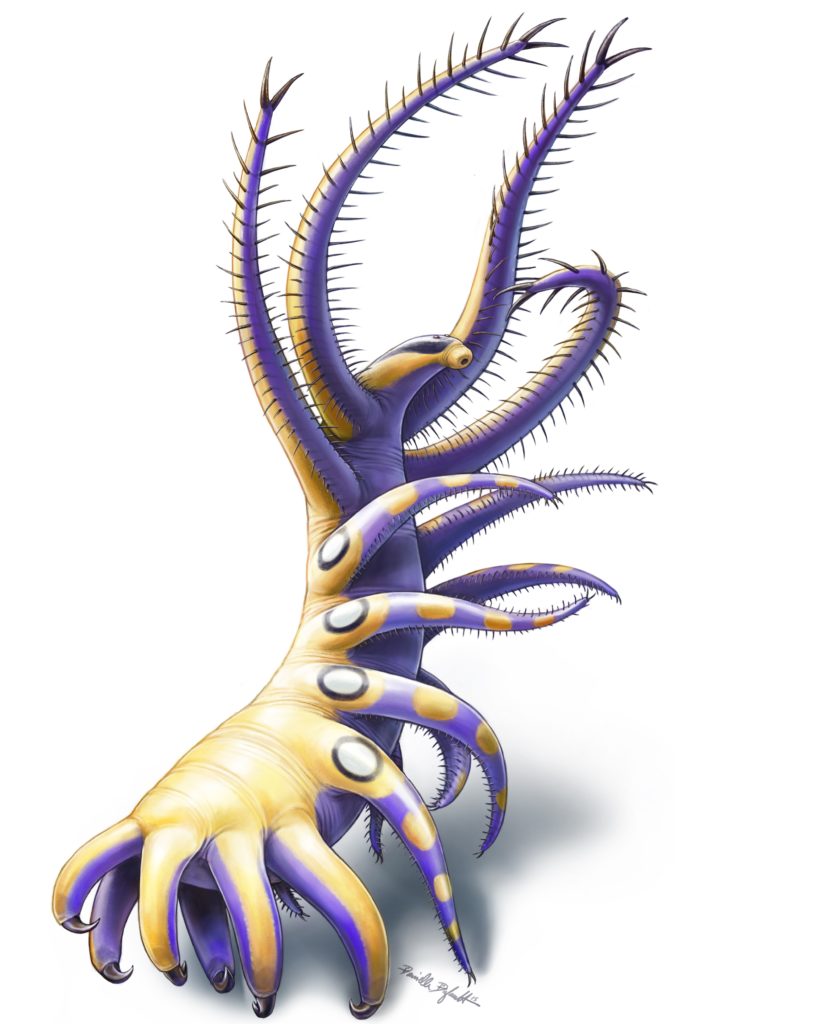
Whether you love them, or can’t stand the sight of them, it cannot be denied that arthropods are the most successful group of animals on the planet, representing a staggering 80% of known species. From the bottom of the sea to the highest permanent habitat, arthropods can be found nearly everywhere that life exists. Forming integral parts of nearly every ecosystem, they cement themselves as the most important group of animals alive on the planet today.
But in order to fully understand arthropod diversity, we must first consider their origins. Fortunately, the large-scale evolutionary relationships between the living arthropod groups (chelicerates, crustaceans, insects, myriapods) are reasonably well agreed upon. If we trace the family tree of arthropods backwards we can see that the insects and crustaceans form the closest branches, then myriapods are next and finally the chelicerates. But as paleontologists, there is always the burning question of ‘but what happened before this?’
Following the tree even further back, beyond what we’d classify as an arthropod, we meet the tardigrades (waterbears/moss piglets), the onychophorans (velvet worms) and, ancestral to all the branches we’ve mentioned so far, are the extinct lobopodians (which mostly resemble spiny worms with legs). This whole expanded group of ‘arthropods and their closest relatives’ is called the Panarthropoda and it is here, with the fossilised lobopodians, that we can discover what the ancestor of most animal species on the planet might have looked like.
This might sound obvious; if the lobopodians are at the base of a tree, then they will surely be the closest approximation to what the ancestor of all members of that group looks like. This is practicably correct, technically incorrect and a massive simplification, all at the same time.
The problems with determining the base of the panarthropod family tree are two-fold:
Firstly, since the lobopodians are all extinct, we cannot obtain their molecular data (e.g. DNA) to construct their family tree, as we do with living species. Similarly, trees that are based on modern molecular data cannot tell us much about fossil species. Therefore, we must turn to the fossil record, and the anatomical information held therein, as the only hard line of evidence.
Secondly, when we examine the oldest lobopodian fossils we can find, they already exhibit high levels of diversity and disparity; there are already lots of them and they’re already different from each other. Amongst all these different kinds of contemporary lobopodians, it’s hard to point at one and say ‘this is the one that best represents the ancestral state’.
Now, a new fossil lobopodian is allowing a revised view of what the panarthropodan ancestor might have looked like. Placed in a phylogenetic analysis (the quantitative method of finding most-likely family trees), Caron & Aria found Ovatiovermis cribratus to be the most primitive member of the panarthropods.

Ovatiovermis was found in the world-famous, half-billion-year-old, fossil lagerstätte (site of special preservation) called the Burgess Shale, in British Columbia, Canada. It possesses the typical worm-like body and smooth legs of the lobopodians, but is unique in that it lacks the defensive spines common in many of its kin. Its body is differentiated from anterior to posterior; the anterior is slender, with long legs which host a double-row of bristles, whilst the posterior is much thicker and robust, with short stubby legs, looking much like root ginger.
The lifestyle of Ovatiovermis has been interpreted to be that of a filter feeder, anchored by its robust rear limbs and combing the water column for food using its toothed front limbs. This interpretation is significant, as it shows a specific function for this anatomy at the very base of the tree. Any subsequent species further down the tree that possess these traits can therefore be inferred to have inherited them from an ancestor with a similar ecology. We can therefore say that the panarthropods evolved from a filter-feeding ancestor.
Well Ovatiovermis (Ovatio – Ovation, vermis – worm), you’ve revealed that the ancestor of >80% of animal species was a filter-feeder, stand up and give yourself a round of applause!
Reconstruction of Ovatiovermis cribratus showing its purported anchored position and frontal lobopods for suspension feeding. Life reconstruction. (Animation by Lars Fields).
Comments